- Home
- Introductions
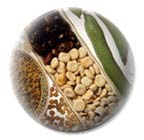
|
Vegetable Seed Production:
You are here: Seed Production: Cucurbitaceae:
Watermelon |
||||||||||||||||||||||||||
 |
Common Name: Watermelon |
 |
In addition to reading the information in this section,
please view this multimedia presentation on Watermelon. (Youtube video) |
Soil Nutrition
Watermelons like a fertile well-drained soil. Lighter soils can be used with irrigation or plasticulture systems. Heavy clay soils are not recommended. Clay soils generally have poor aeration and restricted drainage, which can be detrimental to root growth and increase fruit rot.
Watermelons grow well on slightly acid (pH 6.0 - 6.8) to moderately acid soil conditions.
A crop rotation cycle of several years between planting members from the family Cucurbitaceae is required if pathogen populations are very high and fumigation is not used. When possible, grasses, corn or sorghum are good rotation crops. However, care must be taken that there are no carryover herbicide residues, which might inhibit growth.
Planting
Cucurbit crops are direct seeded. Plants are grownm on raised 60-inch (1.5 m.) beds with either a single row down the middle of the bed (vine types) or two rows, each 6 to 7 inches (15-17.5 cm) off the center of the bed (semi-deteriminate types). Optimum in-row spacings, with the number of plants per acre in parenthesis are: single-row watermelon: 12 to 24 inches (30-60 cm; 4,500-9,000).
Standard watermelon cultivars are often direct-seeded. Seedless watermelons are usually transplanted because germination is poor when direct seeded. However, both types may be transplanted in northern, short season areas but are very sensitive to transplant shock and should be planted only as a plug. The minimum, optimum, and maximum soil temperatures for seed germination are 70 F, 80 F and 100 F, respectively. The optimum for seedless germination is about 90 F. Germination is slow and erratic when soil temperature is below 68 F. Fruit maturing when daily mean air temperatures are below 70 F have poorer quality. Watermelons do well in hot weather.
Spacing depends on the cultivar. Large fruited watermelon are often planted in hills 6 to 9 feet apart with rows also 6 to 9 feet apart. Bush cultivars are planted at much closer spacing with in-row spacing as close as 3 feet with 6 feet between rows. Bush types are mainly used by home gardeners. Large acreages can be seeded in rows six to ten feet apart. Seeds are placed at 0.5 to 1.0 inches deep. In-row spacings of 6 inches are common. Fields may be seeded at higher density to ensure a good stand before thinning to a final spacing at the 2 to 4 leaf stage.
Fruit size may be modified by plant spacing. Closer spacings generally produce smaller fruit and wider spacings generally result in larger fruit.
Irrigation
Watermelon have extensive, moderately deep, root systems but still require a consistent supply of water particularly during fruit development. The recommendation of 1 inch per week definitely applies to this crop. Watermelons require 20 to 25 inches of water during the growing season to maximize yields. Since this amount of water is usually not supplied by rainfall alone. Irrigation is essential. Preplant or post-plant irrigations should be applied to ensure seed germination, emergence and stand establishment. Irrigation is then held off until the pre- vining stage to avoid cooling the soil, encouraging damping-off diseases and encourage deep-rooting.
Drip irrigation, either with or without the use of plastic, is increasingly used particularly in the eastern US. This irrigation method provides the most uniform application of water with the least amount of water used. Sprinkler irrigation is frequently used during stand establishment, but this is not a good system once the vine canopy has become large, because it may result in significant vine and fruit disease. Furrow irrigation is used in production areas in the Southwestern U.S., Western US and Mexico.
Botany
At one time designated as C. vulgaris.
Watermelons are a warm season (frost intolerant) trailing annual, with stems as long as 5 meters with tendrils at the nodes. Watermelons have an extensive but usually shallow root system. Leaves are generally broad and lobed. Flowers are large, yellow, and occur at the nodes. Plants are usually monoecious. Pollination is via bees.
Fruit is edible and globular to oblong.Skin is smooth and weight varies depending on cultivar and growing conditions, ranging from 1 to 60 Kg but mostly 2-10 Kg. Fruit wall is firm and usually thick, 1-4 cm of white inner flesh between hard outer skin and softer interior edible pulp. Seed is imbedded in placental tissue. The greater bulk of the fruit is the solid flesh which is sweet and watery. This is in contrast with many other members of cucurbita where the rind is the principle edible portion. Flesh seldom has a cavity.
Fruit skin color ranges from pale green to blackish green, some yellow and may be solid, striped, or marbled. Flesh color ranges from white through creamy yellow pink to orange reds. Seeds vary in size, number, and color from white through tan, dark brown, and black.
Isolation
The minimum recommended isolation distance of watermelons for seed production is 1000 m. Recommended distances for stock seed are at least 1500 m. It is important to ensure that seed crops are also isolated from market crops.
Pollination
Cucurbits require that pollen move from staminate to pistillate flowers or from the anthers to the stigma of perfect flowers. Honey bees are the msot reliable and cost-effective way to achieve pollination. One to two hives per acre are introduced when 5 to 10 percent of the plants have open flowers. If hives are placed in weedy areas or close to other flowering crops, the number of hives per acre should be increased. Hives should be placed in clusters around the periphery of fields, with additional hives placed inside of larger fields.
F1 hybrids dominate the market for most commerical cucurbit crops due to their greater vigor, higher yield, and greater uniformity than open-pollinated varieties. In addition, since parent lines are proprietary and seed cannot be propagated for a second generation from hybrid seed, seed company investments in varietal research and development are more secure.
Hybrid seed production using plant hormones is not currently feasible for cantaloupes, mixed melons (honey-dew, crenshaw, casaba), or watermelon because they have bisexual flowers that must be emasculated and hand-pollinated. Hybridization of these crops requires extensive hand labor. As a result, hybrid seed production occurs outside the United States where labor is relatively inexpensive and abundant.
Roguing
1. Before flowering: check vegetative characters.
2. At early flowering: check trueness to type of developing fruit.
3. Fruit developing: as for stage 2.
4. Marketable fruit: check fruit characters.
|
Diseases |
Insect Pests |
|
|
Seed Harvest
Sufficient time must be allowed for the seed to reach maturity which
is at least a week later than the optimum stage for marketing the fruit.
The harvesting stage for seed production can be confirmed when the tendrils
have withered on the shoot bearing the fruit. Another sign that the fruit
has reached maturity is the color change from a green/white to pale yellow
of the underside of the fruit (i.e. the surface which has been resting
on the soil).
The method of collecting fruit for seed extraction depends on the scale
of operation. In the USA, where fields for production of watermelon seed
are often at least 10-20 ha (25 - 50 acres), the whole operation is mechanized.
In countries which use a high percentage of hand labor, the entire operation
may be done by hand, especially in smaller areas for stock seed or commercial
seed production.
The specialist machines which have been developed in the USA are either
self-propelled or trailed by a tractor. The self-propelled machines are
capable of picking up the fruits from the plants, but this is done when
the entire crop has reached maturity as it is a once over harvest which
collects all the fruit and destroys the plants.
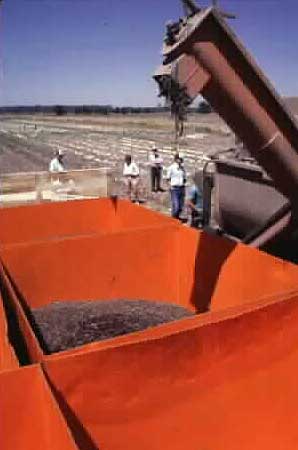 |
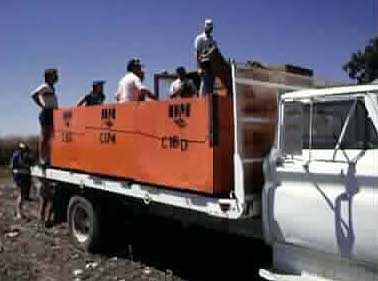 Seeds are augured from the harvester into bins on a truck for transport to the washing facility. |
Hand-harvesting methods are based on the selective cutting of mature
fruits which are put directly into a cucurbit seed extractor. This machine
is towed through the field at a speed compatible with the rate of cutting,
according to the number of workers available.
An alternative system is to cut the mature fruits and place them in wind-
rows or heaps either to await the seed extractor which goes through the
field later, or they are collected for immediate transportation to a central
area where the extraction is done.
Cleaning
The seeds in the watermelon fruit, unlike most cucurbits, are distributed
throughout the central area of the fruit pulp and not in a central fruit
cavity. Therefore, hand extraction methods depend on fruit maceration
rather than a scooping process.
The macerated pulp containing the seeds is washed by running water into
a screen; this operation separates the pieces of rind and coarse material
from the seeds and fine pulp. The seeds pass through to a finer meshed
screen which retains them. The better the initial maceration of pulp,
the more efficient is the separation by screens, resulting in a cleaner
seed sample.
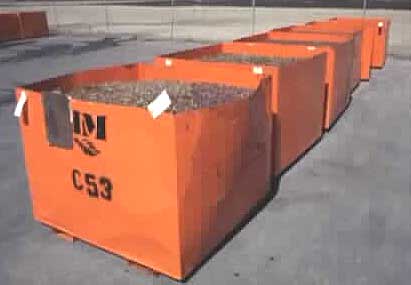 Vine seeds may be fermented for short periods but must be prevented from heating due to microbial activity. |
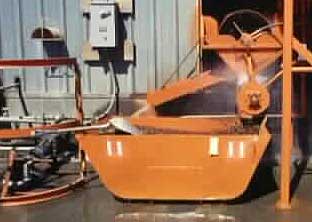 Vine seeds are washed and brushed to remove debris and sugars. |
Fermentation is not normally used in the extraction or cleaning of watermelon seed because the seed easily discolors and potential germination is reduced by fermentation.
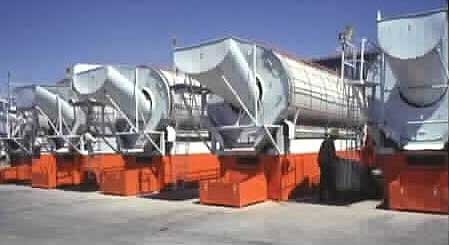
Rotary driers dry seeds after washing
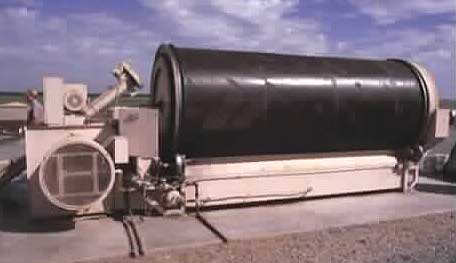
Seed Yield
The average seed yield of most watermelon cultivars under good conditions
is 400 kg/ha (357 pounds / acre). The popular cultivar 'Charleston Gray'
is a relatively low seed yielder and an average yield is only 250 kg/ha
(223 pounds / acre). Under the relatively poor cultural conditions found
in some tropical countries, seed yields of the better yielding cultivars
are as low as 100 kg/ha (89 pounds / acre) with cv. Charleston Gray yielding
even less. A relatively short growing season also affects seed yield adversely.
A lower yield of fruit is achieved when the fruit is left on the plant
for seed production than if fruits are promptly harvested as they reach
market maturity.
The 1000 grain weight depends on the cultivar but the approximate weight
of 1000 seeds is 113g.
 |
View this narrated video to learn more about watermelons as a crop and an art form in the US and South East Asia. This presentation contains information on watermelon carving and grafting not found else where in this lesson. (The video will open in a new window.) |
Seed Identification:
| Scientific Name: | Citrullus lanatus |
| Common Name: | Watermelon |
| Family: | Cucurbitaceae |
| Weight: | 250 - 500 seeds/ounce |
|
|
|
| Print image with name - Print image without name | |